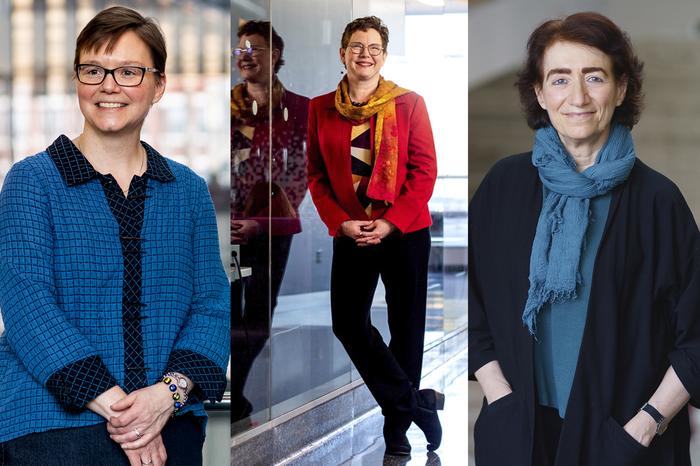Three Northeastern leaders have been named fellows of the American Association for the Advancement of Science—a lifetime honor awarded to scholars for their exceptional contributions and leadership in their scientific fields.
Elizabeth Mynatt, dean of the Khoury College of Computer Sciences at Northeastern, was selected for her outstanding community leadership and exceptional contributions to human-centered computing.
Hazel Sive, dean of the College of Science, received the recognition for fundamental discoveries advancing our understanding of early embryonic development, particularly the development of the nervous system in vertebrates, and for her leadership in teaching, mentoring, and diversity in higher education.
Penny Beuning, chair of the Department of Chemistry and Chemical Biology at Northeastern, was chosen as a fellow for key discoveries in the way cells respond to DNA damage, and for research that underpins our understanding of the process by which cells copy that damage, or don’t.
Mynatt, Sive, and Beuning join the ranks of other Northeastern leaders to receive this fellowship. That prestigious group includes university president Joseph E. Aoun, provost and senior vice president David Madigan, dean of inclusive computing Carla Brodley, director of the Marine Science Center Geoffrey Trussell, university distinguished professor of psychology Lisa Feldman Barrett, and university distinguished professor of biology Kim Lewis, among others.
“It’s very exciting and a great honor,” Mynatt says. “It’s terrific to have greater recognition in AAAS for our field as a whole. I’m also very excited about my peers who are being recognized this year. I’m excited that that work is being valued.”
Elizabeth Mynatt
Mynatt describes her research in human-centered computing as “innovating at the edge of technology.” She uses scientific processes to understand humans’ foundational needs and human nature in order to build technology that better meets them as they are.
Mynatt’s work addresses challenges in human-centered computing, from building assistive technologies to make computing accessible for people who are visually impaired, for example, to augmenting existing technologies to help people with early-stage diseases navigate their diagnoses and daily life while maintaining independence.
Northeastern appoints human-centered computing pioneer as dean of the Khoury College of Computer Sciences
read moreOne such endeavor of Mynatt’s has focused on leveraging voice assistants, such as Google Home or Amazon’s Alexa, to help people with early-stage Alzheimer’s remain independent and continue to do things that could otherwise be unsafe, like cooking. Mynatt and colleagues are studying how people recently diagnosed with Alzheimer’s use such technologies, and are designing applications that fulfill their needs and preferences best.

For example, if you’re sometimes forgetful, a regular medication schedule can be tricky. But, Mynatt says, researchers have found that medication reminders typically don’t work. “They go off, people ignore them,” she says. “You forget about them as soon as they’ve gone off. People don’t like them.” So instead, Mynatt and her team worked with study participants to create a system that checks in.
“There’s a subtle aspect in the psychology of the design,” she says. Instead of reprimanding or annoying a user, the voice assistant can instead be affirming, asking someone if they’ve already taken their medicine rather than telling them to.
Mynatt is also an advocate for more support for such intersectional human-centered computing research across the country. Technology, she says, doesn’t operate in isolation. Humans use it, interact with it, and repurpose it to fit in their lives.
“Computing research has these large societal ramifications,” Mynatt says. “Too often people think that computing is, you know, just Google or just Microsoft. But it has to do with our health and our wellbeing, and our cities and our families.”
Hazel Sive
The theme of Sive’s career has been understanding the intricate process of how biological bodies with a spine are built. “How do you build something like a human?” she says. “It’s an extraordinary engineering process.”
Sive’s research starts essentially at the beginning, examining the fundamental processes that shape how a single cell develops into an embryo and then into a creature with a spine, a brain, a face, and all kinds of other distinct features. Understanding how that happens can shed light on what occurs when something goes wrong.
One big revelation that Sive made was to identify just how interconnected the development of the face and the brain are in vertebrates. She and her colleagues discovered that the same region of the embryo that forms the mouth is also “a signaling center that sends out lots of chemicals that influence the ultimate outcome of the surrounding cells,” she explains. It controls the size of the face and the brain.
Landmark study into genetic disorder offers clues into links between metabolism and mental health
read moreThat revelation could help lead to treatments for a severe condition called microcephaly, which is when a baby is born with a smaller head and brain than expected. Previously, Sive says, it was thought that something was wrong in the individual cells. “Our work has shown that there is a mechanism—that is this big signaling center, that there’s one place that’s controlling the size of the brain and face, and that leads to new types of thinking about what you might do to correct this.”
Sive often thinks to ask why when many other researchers are focused on how something develops. That reframing of the research question led her to do pioneering work exploring why the whole central nervous system develops as a tube, opening up a new line of inquiry into the nervous system. The answer: The brain and spinal cord are filled with cerebrospinal fluid, which bathes the brain and is key to the survival of brain cells.
Sive also loves to teach, and has begun several initiatives to develop the future of the field. For example, she began a course at Cold Spring Harbor Laboratory on Long Island three decades ago to teach people how to look after, raise, and study frogs as a model vertebrate system. “It’s still running today,” she says. “I’m really proud of it.”
Sive also has explored the link between metabolism and mental health in her work. In a study published late last year, Sive and her colleagues were able to show that genetic disruptions affecting the way fats and proteins bind to each other inside the cells of people with a specific genetic condition resulted in abnormalities in neuron function, which in turn led to behavioral changes and other symptoms.
“Even after many years of study, we are certainly not done,” Sive says. “The vistas of science open up constantly. The importance of the work opens up, the contributions open up all the time. And so we are continuing along this important scientific walk here at Northeastern.”
Penny Beuning
Biology can be damaged, at its most fundamental levels, by things such as air pollution, radiation, or even your normal metabolism. Beuning studies how cells keep that damage from wreaking further havoc.
In a living organism, there are cells that are constantly dividing, replacing themselves with new ones as they die off. Skin cells are a prime example. In that process, a cell must replicate its DNA so that each new cell has all of the genetic information that it needs to function. But if there is damaged DNA in a cell that is trying to replicate, most of the cellular machinery simply won’t make the copy.
“We have a lot of processes in our cells that prevent DNA damage from becoming mutations,” Beuning says. “Just missing one of them can be very bad.”
But if replication is halted, the dying cells won’t be replaced by new ones and an organism could suffer a disease, injury, or even death as a result. So one mechanism—which is a main focus of Beuning’s research—forges ahead and allows the replication process to continue, despite the damage, essentially setting it aside to deal with later. That process is called DNA translesion synthesis.
They want to reveal the chemistry of every enzyme ever
read moreIt was thought that DNA translesion synthesis let damaged DNA replicate because the enzymes in charge of that process make mistakes, Beuning says. The idea was that “they are just sloppy and copy anything, that they don’t have the mechanism that checks that the base pairs are correct.”
But Beuning’s research found evidence that there is a kind of checking mechanism. “They are quite error-prone,” she says. “But they’re not as bad as random chance. There is a mechanism that makes them better than random chance.”
The next step, she says, is to understand how the enzyme that facilitates that process knows when DNA is damaged. How does that checking mechanism work?
Better understanding this mechanism could lead to improved cancer treatments. Some chemotherapy drugs work by damaging DNA in a tumor so that it stops growing. But this mechanism that copies damaged DNA—DNA translesion synthesis—can make a cell resistant to chemotherapy, Beuning says. And there’s evidence that the cells targeted by chemotherapy tend to ramp up that process more than normal cells, in an apparent attempt to evade the cancer-killing therapy.
“It is like the [cancerous] cell is trying to defend itself,” she says. “So we hope that by understanding more about how these proteins work, we might be able to predict that or better understand what is happening there.”
For media inquiries, please contact media@northeastern.edu.









